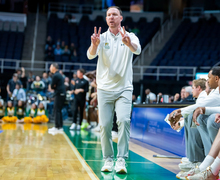Mixed media jellyfish come to life at ‘Trophies’ exhibit
Courtesy of Jamie Young
Using unconventional materials, artist Roberta Griffith’s jellyfish exhibit at the Everson Museum of Art shows trophies through a new lens. Griffith’s first exhibit at the museum dates back to 1962.
Get the latest Syracuse news delivered right to your inbox.
Subscribe to our newsletter here.
Ceramic, feathers and plexiglass create a sea of floating jellyfish at the Everson Art Museum. Roberta Griffith’s collection of fishy sculptures, titled “Trophies,” are stark against a wall of orange paint, providing a unique look at beauty under the sea and above the surface.
“I find these very interesting, because they’re ‘trophies,’ but I see them as living things,” said Stephanie Adams, an employee at the Everson Art Museum. “If I were to get a trophy, I think I would rather get something like this over your basic gold thing.”
Griffith’s art has been in the Everson Art Museum since 1962, when her work was first displayed in the Ceramic National Exhibition. Garth Johnson, curator of ceramics at the Everson Art Museum, defines Griffith’s art style as audacious, with each piece carrying a deep message.
Griffith, an American mixed-media artist and Fulbright Grant recipient, works mainly with ceramics. As an award-winning artist since the age of 10, Griffith has produced and been celebrated for her decades of innovative artistic ideas. In Spain, she studied under renowned ceramists like Josep Llorens Artigas and Joan Miró.
“This exhibit is both a celebration of Roberta’s long career and a look at the special conditions of the early 1970s in ceramics,” Johnson said. “I would say that we’re being very true to Roberta’s intentions when she made the work.”
Johnson first became acquainted with Griffith in 2018, when the Everson displayed “Isadora in Black Lace,” a tribute to high-profile dancer Isadora Duncan, who was strangled by her own scarf in 1927 when it was caught in the wheels of her car. Griffith uses a darkened ceramic plate with a delicate piece of lace draped across it to tell the story of Duncan’s death.
As a testament to emerging developments in ceramics, Griffith experiments with mixed-media in “Isadora in Black Lace,” juxtaposing a hard, hand-thrown ceramic plate with fragile lace. In “Trophies,” she combines solid clay with soft feathers.
“I have known Roberta as a human being for longer than I have known her art,” Johnson said. “(The piece is) also sensual and innovative… but it masks a horrific story. Roberta definitely knows how to inject a bit of ‘grit’ into beauty.”
Griffith’s design choices mark the evolution of artwork that occurred in the 1970s, when Johnson said ceramists transitioned from “sleek mid-century silhouettes to embrace sensuality.”
From bulbous ceramic heads to little ones, and canary yellow feathers to speckled gray ones, the sea creatures stand out from one another. Cesar Barrera, a freshman in the College of Arts and Sciences, appreciates this diversity in appearance.
“The design of each trophy is unique in its own way. Each trophy comes with its own design,” Barrera said.
According to the Everson website, “Trophies” is a multifaceted exhibit. It is not only a quirky spin on whimsical underwater creatures but also a feminist stand in a male-dominated field. As a woman producing artwork in the 1970s, Griffith challenged the status quo. Now, half a century later, her art is celebrated for being a bold shout in a sea of voices aiming to drown her out.
“Roberta is a living legend.” Johnson said. “These strange and wonderful objects still have the power to delight and surprise… This is a victory lap for an artist with a long history with Everson.”
Published on October 18, 2023 at 11:07 pm






